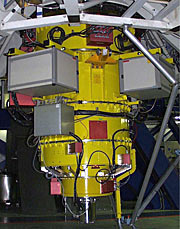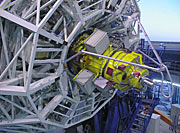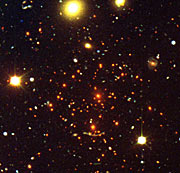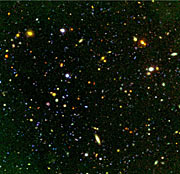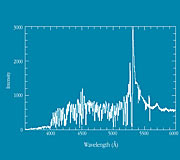Tisková zpráva
New Photos from FORS at the VLT UT1
26. listopadu 1998
Following the installation and first commissioning period of FORS1 at the first 8.2-m VLT Unit Telescope (UT1), the FORS Team is now busy reducing the wealth of data obtained during this first series of test observations. Apart from allowing the assessment of the technical performance of the instrument, a number of images can also be used for extracting information of scientific interest.
Some of the new deep images from FORS1 are presented here together with a spectrum of a distant quasar.
Abell 370 Cluster of Galaxies with Gravitational Arcs
eso9857c shows a composite colour image of the Abell 370 cluster of galaxies . This cluster hosts one of the most prominent gravitational arcs known to date.
The light of a very distant object is deformed by the foreground cluster. Abell 370, at the center of the photo, contains a large number of galaxies - most of them are ellipticals. The two brightest red galaxies slightly above the gravitational arc are the most massive in the cluster and give an important contribution to the lensing event.
This gravitational arc - in combination with the cluster of galaxies - provides a natural laboratory to study the physics of gravity. The deformation of "space-time" by the large mass of Abell 370 can be derived and modeled from the slope of the gravitational arc. The exact shape of the arc allows to estimate the mass of the cluster through the equations of general relativity. This estimate agrees with independent determinations from the X-ray emission and the motion of the galaxies in the cluster.
FORS Deep Field near Q0103-260
eso9857d During the commissioning of FORS1, "deep fields" were observed in order to estimate the limiting magnitudes of the new instrument. Fields were selected which do not contain bright stars that might reduce the image quality due to scattered light.
This FORS "deep field" hosts the quasar Q0103-260 which was also investigated spectroscopically (see ESO Press Photo eso9857e below). In this image, the quasar is visible as a bright white source near the bottom, to the lower left (south-east) of the prominent spiral galaxy.
This field has a very low intergalactic extinction (absorption of light by intervening matter) and therefore allows a very deep look into the distant Universe. A preliminary reduction shows that the galaxy sample is complete down to about magnitude 26.5 in R (red) and 27.5 in the B (blue) band.
The shown field is crowded with several thousands of galaxies of different types and shapes. Their colours will allow an estimate of their distances, with blue objects being closest. Among the reddest objects, it is possible to find candidates of very distant, possibly primeval, galaxies, which will be further investigated spectroscopically with FORS.
Spectrum of Quasar Q0103-260
eso9857e displays a spectrum of the distant quasar Q0103-260 (visual magnitude V = 18.8 , redshift z = 3.36 ) with a prominent emission line at 5300 Å (530 nm), identified as the Lyman-alpha resonance line of atomic hydrogen, redshifted from 1216 Å to 5300 Å.
To the left of the Lyman-alpha emission line, the "Lyman-alpha forest" is clearly seen; it is formed by numerous Lyman-alpha absorption lines of hydrogen clouds of lower redshift and located between the quasar and us. Q0103-260 is a particularly interesting object for studying the Lyman forest, since this quasar is in a region close to the south galactic pole (i.e. the direction perpendicular to the Milky Way plane) with its exceptionally low density of foreground stars and foreground galaxies. It will accordingly be possible to obtain with FORS very deep images and spectra of faint very distant objects in the field around this quasar and thus to search for objects which may cause the hydrogen absorption features in the quasar spectrum.
Další informace
Technical Information:
- The photo is a combination of three exposures through R- (red; centered at 657 nm and with FWHM 150 nm), B- (blue; 429 nm and FWHM 88 nm) and U-band (ultraviolet; 366 nm and FWHM 36 nm) filters and with exposure times of 240, 300 and 500 sec, respectively. Only one quarter (1050 x 1050 pix) of the full image is displayed here. The seeing was 0.9 arcsec in R and B, and 1.1 arcsec in the U-band filter. The field measures 3.5 x 3.5 arcmin with North at the top and East to the left.
- Technical Information: This image consists of three exposures in filters I (near-infrared; centered at 768 nm and with FWHM 140 nm), R and B with exposure times 2700, 1200 and 2200 seconds, respectively. The field shown corresponds to one quarter (1050 x1050 pix) of the full image. The seeing was 0.8 arcsec in I and R, and 0.9 arc in B. Contrary to the previous image, the intensity scale here represents the square root of the flux. The field measures 3.5 x 3.5 arcmin with North at the top and East to the left.
- Technical Information: This spectrum is based on a 30 min exposure, taken with a 1.0 arcsec slit and a grism with 600 lines/mm blazed in the blue spectral range
O zprávě
| Tiskové zpráva č.: | eso9857 |
| Legacy ID: | Photo 47a-e/98 |
| Jméno: | Abell 370, FORS1, Q0103-260, Very Large Telescope |
| Typ: | Local Universe : Technology : Observatory : Telescope Early Universe : Galaxy : Activity : AGN : Quasar Early Universe : Galaxy : Grouping : Cluster Early Universe : Cosmology : Morphology : Deep Field Unspecified : Technology : Observatory : Instrument |
| Facility: | Very Large Telescope |
| Instruments: | FORS1 |
Our use of Cookies
We use cookies that are essential for accessing our websites and using our services. We also use cookies to analyse, measure and improve our websites’ performance, to enable content sharing via social media and to display media content hosted on third-party platforms.
ESO Cookies Policy
The European Organisation for Astronomical Research in the Southern Hemisphere (ESO) is the pre-eminent intergovernmental science and technology organisation in astronomy. It carries out an ambitious programme focused on the design, construction and operation of powerful ground-based observing facilities for astronomy.
This Cookies Policy is intended to provide clarity by outlining the cookies used on the ESO public websites, their functions, the options you have for controlling them, and the ways you can contact us for additional details.
What are cookies?
Cookies are small pieces of data stored on your device by websites you visit. They serve various purposes, such as remembering login credentials and preferences and enhance your browsing experience.
Categories of cookies we use
Essential cookies (always active): These cookies are strictly necessary for the proper functioning of our website. Without these cookies, the website cannot operate correctly, and certain services, such as logging in or accessing secure areas, may not be available; because they are essential for the website’s operation, they cannot be disabled.
Functional Cookies: These cookies enhance your browsing experience by enabling additional features and personalization, such as remembering your preferences and settings. While not strictly necessary for the website to function, they improve usability and convenience; these cookies are only placed if you provide your consent.
Analytics cookies: These cookies collect information about how visitors interact with our website, such as which pages are visited most often and how users navigate the site. This data helps us improve website performance, optimize content, and enhance the user experience; these cookies are only placed if you provide your consent. We use the following analytics cookies.
Matomo Cookies:
This website uses Matomo (formerly Piwik), an open source software which enables the statistical analysis of website visits. Matomo uses cookies (text files) which are saved on your computer and which allow us to analyze how you use our website. The website user information generated by the cookies will only be saved on the servers of our IT Department. We use this information to analyze www.eso.org visits and to prepare reports on website activities. These data will not be disclosed to third parties.
On behalf of ESO, Matomo will use this information for the purpose of evaluating your use of the website, compiling reports on website activity and providing other services relating to website activity and internet usage.
Matomo cookies settings:
Additional Third-party cookies on ESO websites: some of our pages display content from external providers, e.g. YouTube.
Such third-party services are outside of ESO control and may, at any time, change their terms of service, use of cookies, etc.
YouTube: Some videos on the ESO website are embedded from ESO’s official YouTube channel. We have enabled YouTube’s privacy-enhanced mode, meaning that no cookies are set unless the user actively clicks on the video to play it. Additionally, in this mode, YouTube does not store any personally identifiable cookie data for embedded video playbacks. For more details, please refer to YouTube’s embedding videos information page.
Cookies can also be classified based on the following elements.
Regarding the domain, there are:
- First-party cookies, set by the website you are currently visiting. They are stored by the same domain that you are browsing and are used to enhance your experience on that site;
- Third-party cookies, set by a domain other than the one you are currently visiting.
As for their duration, cookies can be:
- Browser-session cookies, which are deleted when the user closes the browser;
- Stored cookies, which stay on the user's device for a predetermined period of time.
How to manage cookies
Cookie settings: You can modify your cookie choices for the ESO webpages at any time by clicking on the link Cookie settings at the bottom of any page.
In your browser: If you wish to delete cookies or instruct your browser to delete or block cookies by default, please visit the help pages of your browser:
Please be aware that if you delete or decline cookies, certain functionalities of our website may be not be available and your browsing experience may be affected.
You can set most browsers to prevent any cookies being placed on your device, but you may then have to manually adjust some preferences every time you visit a site/page. And some services and functionalities may not work properly at all (e.g. profile logging-in, shop check out).
Updates to the ESO Cookies Policy
The ESO Cookies Policy may be subject to future updates, which will be made available on this page.
Additional information
For any queries related to cookies, please contact: pdprATesoDOTorg.
As ESO public webpages are managed by our Department of Communication, your questions will be dealt with the support of the said Department.

